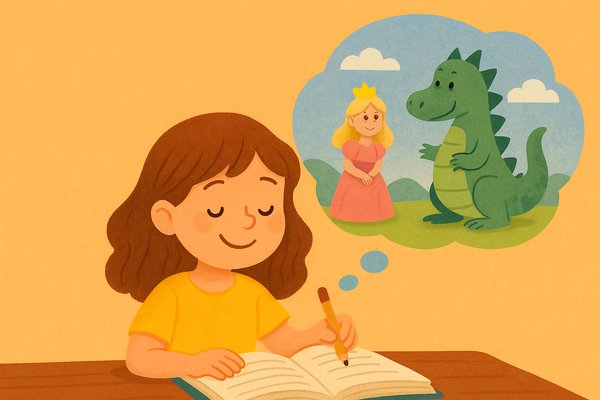Why Children Love Inventing Their Own Story Endings

**Picture this:** you’re reading a bedtime story to your child, and just before the big finale you pause and ask, *“What do you think happens next?”* Instantly, their eyes light up as they dream up a wild ending of their own. Children love having a say in how a story ends – and for good reason. A new storytelling platform called **What Happens Next?** was built entirely around this idea. It offers interactive tales that deliberately stop short, inviting kids and teens to finish the story their way. In this online world, nothing is finished until your child decides what happens next [whathappensnext.online](https://whathappensnext.online). The platform’s founder has even published a series of printed storybooks in the same series, so families can enjoy these open-ended adventures offline as well. Encouraging children to create their own endings isn’t just great fun – it also brings *tremendous* educational and psychological benefits, from sparking creativity to building empathy. Below, we explore why letting kids “be the author” is so rewarding for them.
## From Passive Listener to Active Storyteller
When a child gets to shape the ending of a story, something magical happens: they go from being a passive listener to an **active storyteller**. Instead of merely absorbing the plot, they start *building* it. As one educator puts it, if you start a story and then stop midway to ask *“What happens next?”*, it **“turns passive listeners into active creators.”** Suddenly the child isn’t just listening – they’re solving problems and flexing their imagination [noahsquest.com](https://noahsquest.com/2025/08/01/tales-that-teach-storytelling-as-a-tool-for-innovation-and-empathy-in-kids/#:~:text=Ditch%20the%20polished%20endings%20and,permission%20to%20dream%20out%20loud). This sense of involvement is thrilling for kids. They realise their ideas can influence the story, which makes storytime far more engaging than when every plot neatly ties up without their input.
Moreover, giving children “permission to dream out loud” by inventing their own twists helps them see themselves as creators [noahsquest.com](https://noahsquest.com/2025/08/01/tales-that-teach-storytelling-as-a-tool-for-innovation-and-empathy-in-kids/#:~:text=Ditch%20the%20polished%20endings%20and,permission%20to%20dream%20out%20loud). Even if their ideas send the tale off the rails, that’s part of the fun. There’s no “right” or wrong ending – what matters is that it’s their ending. This empowerment builds confidence and encourages kids to contribute more. No wonder a child often begs to tell you a story next or asks to change the ending again and again!
## Sparking Creativity and Imagination
One of the biggest benefits of open-ended storytelling is how it supercharges a child’s **creativity**. When kids are asked to imagine an ending, they have to think outside the box – *anything* can happen next! Research has shown that this kind of open-ended narrative play boosts divergent thinking skills. In fact, a 2023 University of Cambridge study found that children who engaged in open-ended storytelling became **62% better at divergent thinking**, a key measure of creativity [noahsquest.com](https://noahsquest.com/2025/08/01/tales-that-teach-storytelling-as-a-tool-for-innovation-and-empathy-in-kids/#:~:text=problems%20by%20painting). In other words, making up their own endings helps kids learn to generate lots of different ideas and solutions.
Not only that, but children also tend to remember stories better when they get involved. The same study reported that kids recalled the story *2.4 times more* accurately when they could interact with it (for example, by deciding the ending) than when they just listened passively [noahsquest.com](https://noahsquest.com/2025/08/01/tales-that-teach-storytelling-as-a-tool-for-innovation-and-empathy-in-kids/#:~:text=problems%20by%20painting). Clearly, creativity and learning thrive when a child’s imagination is in the driver’s seat.
Parents often find that a simple change – leaving a story unfinished for the child to complete – can ignite enormous imaginative energy. That small twist turns storytime into a game of “let’s pretend,” where your child might suddenly propose flying cats or time machines to resolve a cliffhanger. The plot might get fantastically silly, but that’s exactly the point. By encouraging these flights of fancy, we give kids’ **imaginations a workout**. They learn to invent ideas freely, which is the foundation of creative thinking in all areas of life.
## Building Narrative Skills and Confidence
Inventing story endings also helps children develop strong **narrative skills** and communication abilities. To create a satisfying ending, a child must understand the story’s characters and plot, then imagine a logical (or delightfully unexpected!) way to tie things up. In doing so, they practice putting events in sequence and coordinating ideas into a coherent tale. Educators note that when children imagine what might happen next and *invent their own endings*, they are *“practicing how to coordinate ideas and express themselves.”* This kind of activity **builds creative thinking and communication skills** [noahsquest.com](https://noahsquest.com/2025/08/01/tales-that-teach-storytelling-as-a-tool-for-innovation-and-empathy-in-kids/#:~:text=Engaging%20the%20children%20in%20the,creative%20thinking%20and%20communication%20skills). In other words, finishing a story exercises the same muscles children use in writing and speaking – it’s training in structuring a narrative.
Crucially, coming up with their own ending also nurtures a child’s **voice and confidence** in storytelling. They learn that their ideas have value, especially when you listen intently or even write down their ending to revisit later. Teachers often encourage pupils to write alternative endings to familiar tales for this reason. It shifts the focus from memorising facts to playing with ideas, which builds self-expression. In UK primary classrooms, for example, many creative writing exercises involve imagining a different ending to a story, with resources specifically designed to make this process accessible and fun [twinkl.com](https://www.twinkl.com/resource/t2-or-518-writing-an-alternative-ending-to-a-traditional-tale-little-red-riding-hood-differentiated-activity-sheet#:~:text=Writing%20an%20Alternative%20Ending%20to,focus%20on%20their%20creative%20ideas). By regularly crafting their own narratives, children become more comfortable with language and more confident in their ability to tell a story. Over time, you might notice your shy reader blossoming into an enthusiastic storyteller.
## Cultivating Empathy and Emotional Intelligence
Another beautiful advantage of inviting children to create endings is that it can deepen their **empathy** and emotional understanding. Stories by their nature allow kids to *“step into someone else’s shoes and feel empathy,”* as the UK’s National Storytelling Week organisers put it [literacytrust.org.uk](https://literacytrust.org.uk/resources/national-storytelling-week/#:~:text=This%20fantastic%20annual%20event%20is,help%20develop%20essential%20literacy%20skills). When a child ponders how a character might feel or act at the end of a tale, they’re practicing exactly that – considering perspectives other than their own. For example, if the hero is stuck in a cave, your child might think about the hero’s feelings (scared, determined, hopeful?) and then decide on an ending that resolves those feelings. This process helps children learn to recognise and name emotions, both in others and in themselves, which is a key aspect of **emotional intelligence**.
In fact, child development experts note that inviting kids to change a story’s ending can **strengthen emotional intelligence** over time [noahsquest.com](https://noahsquest.com/2025/08/01/tales-that-teach-storytelling-as-a-tool-for-innovation-and-empathy-in-kids/#:~:text=imagination%2C%20and%20decision,with%20curiosity%20rather%20than%20fear). By exploring different outcomes – maybe one ending is funny and lighthearted, while another is thoughtful or bittersweet – children safely explore a range of emotions and consequences. They see how different actions lead to different results, which improves their understanding of cause and effect in social situations. Storytelling thus becomes a gentle training ground for real-life empathy and decision-making. It’s easier for a young one to discuss a character’s fear or sadness within a story, and through that discussion they learn to handle their own emotions more confidently.
Moreover, co-creating endings with your child opens up conversations about why characters make certain choices. This can lead to incredibly meaningful chats about values and feelings. For instance, “Why do you think the princess forgave her friend in your ending? How did the friend feel?” Such dialogues nurture your child’s ability to put themselves in someone else’s position and understand diverse perspectives – a life skill that stories are perfect for teaching.
## Storytelling in UK Homes and Classrooms
Britain has a rich tradition of storytelling, both at home and in schools, which makes this activity especially resonant for UK parents. From classic bedtime tales to school literacy projects, narrative imagination is highly valued. The National Curriculum for English, for example, emphasises the importance of spoken storytelling and imaginative writing in developing children’s cognitive and social skills [assets.publishing.service.gov.uk](https://assets.publishing.service.gov.uk/media/5a7de93840f0b62305b7f8ee/PRIMARY_national_curriculum_-_English_220714.pdf#:~:text=Spoken%20language%20The%20national%20curriculum,developing%20their%20vocabulary%20and%20grammar). In practice, this means many primary teachers incorporate creative story exercises – like coming up with alternate endings – to meet learning goals and keep students engaged. Teaching resources often provide prompts for alternate endings, allowing pupils to focus on their creative ideas while learning about story structure [twinkl.com](https://www.twinkl.com/resource/t2-or-518-writing-an-alternative-ending-to-a-traditional-tale-little-red-riding-hood-differentiated-activity-sheet#:~:text=Writing%20an%20Alternative%20Ending%20to,focus%20on%20their%20creative%20ideas). It’s a fun way to hit curriculum targets for composition and narrative skills without kids even realising they’re “doing work”!
Culturally, British parents are encouraged to read widely with their children, and letting kids take the storytelling reins can be a delightful twist on the usual routine. National events like **National Storytelling Week** celebrate the power of sharing stories and highlight how storytelling builds empathy and literacy skills in young people [literacytrust.org.uk](https://literacytrust.org.uk/resources/national-storytelling-week/#:~:text=This%20fantastic%20annual%20event%20is,help%20develop%20essential%20literacy%20skills). So by inviting your child to imagine *“what happens next”*, you’re in step with a broader movement in the UK that sees storytelling as key to learning and bonding. It’s an approach that aligns with both modern educational thinking and the age-old British love of a good story.
Finally, don’t forget that resources like the *What Happens Next?* platform can support you in this creative journey. If you’re not sure where to begin, you can pick an unfinished story from the website and ask your child to craft an ending. The printed **What Happens Next?** books offer the same concept in physical form – perfect for a screen-free story time that still sparks interactive fun. Both at home and in the classroom, these tools tap into children’s natural enthusiasm for storytelling.
**In conclusion**, giving your child the chance to invent their own story endings is a simple idea with profound benefits. It turns storytime into a two-way adventure, lighting up your child’s creativity, boosting their narrative skills, and helping them grow in empathy and emotional insight. Best of all, it’s **tremendous fun** for both child and parent. So next time you reach the climax of a bedtime story, try pausing and asking, *“What do you think happens next?”* You might be amazed at the imaginative ideas that pour out. By embracing their inventive endings – and maybe even exploring platforms like *What Happens Next?* for inspiration – you’ll be nurturing a love of storytelling that can last a lifetime. After all, every story is an opportunity for your child to say, *“Let me tell you how I would end it…”*, and in doing so, to learn and grow through the magic of their own imagination.
**References:**
* [What Happens Next?](whathappensnext.online) Interactive story platform
* [Noah’s Quest](https://noahsquest.com/2025/08/01/tales-that-teach-storytelling-as-a-tool-for-innovation-and-empathy-in-kids/) – Storytelling as a Tool for Innovation and Empathy (Justin Belmont quote).
* [National Literacy Trust](https://literacytrust.org.uk/resources/national-storytelling-week) – What is National Storytelling Week?
* [Twinkl Teaching Resources](https://www.twinkl.com/resource/t2-or-518-writing-an-alternative-ending-to-a-traditional-tale-little-red-riding-hood-differentiated-activity-sheet) – Alternative Ending Writing Prompts.
* [UK National Curriculum](https://assets.publishing.service.gov.uk/media/5a7de93840f0b62305b7f8ee/PRIMARY_national_curriculum_-_English_220714.pdf) – Importance of spoken language in development.
* [amazon.co.uk](https://amzn.eu/d/eEdMBtX) - you can buy a book on Amazon

 English
English
 polski
polski



